How Deep Is The Water In Synchronized Swimming
Synchronized Swimming - Quick Guide
Synchronized Pond - Overview
Synchronized pond is a game where a grouping of athletes perform dance steps in combination with pond. The dance is performed according to the tune played in groundwork. This tutorial explains the basics of synchronized pond and how to become a professional person synchronised swimmer.
Similar other events in swimming, players tin perform solos, duets, combos or squad. There are two routines in synchronized swimming −
-
Technical routine − In technical routine, the players perform according to a ready of predetermined steps. Information technology should be performed strictly according to sure guidelines.
-
Free routine − Here, the steps are not predetermined, and then the players are free to choose their own steps. In free routine, the players have to show their creativity in choreography, dancing, and coordination.
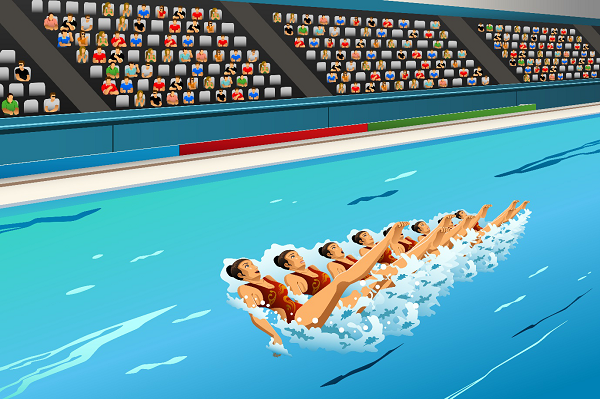
A Little History of Synchronized Swimming
Synchronised swimming was very famous before it was included in Olympics. For the offset time, information technology was played in 1891 every bit recorded in history. At that time, information technology was played in Berlin, Germany. Afterward seeing the event, many countries became interested in playing this sport and many clubs were formed. Simultaneously, this sport became popular in US and Canada.
For the first time, synchronised swimming was included in Los Angeles Olympics in 1984. Between 1984 and 1992, information technology was played with two events solo and duet. In 1996 Atlanta Olympics, only team upshot was included. But from 2000 Olympics held in Sydney, two events i.due east. duet and squad events were held and now synchronised swimming has become a crowd pulling sport.
Participating Countries
Since its inception, the game became very famous in many Asian and Not-Asian countries. Performers from different countries perform every year in world aquatic championships. Recent globe championship (2015) was held at Kazan, Russia.
The post-obit countries have dominated the sport in case of medals.
- United States
- China
- Russia
- Commonwealth of australia
- East Germany
Synchronized Swimming - Equipment
Synchronised swimming is a class of rhythmic pond where the athletes have to answer according to the music and have to swim or dance in water appropriately. Hence, the equipment used in this sport are quite dissimilar from other swimming sports.
Before moving on to the equipment used by the athletes, allow us first go to know near the playing environment where synchronized pond is performed.
Playing Environment
Synchronized swimming is played in a specially designed pool. The water in the puddle must be clean and the temperature of the water must exist around 25 degree Celsius. The size of the pool must exist a minimum of 20m by 30m, and within that a 12m by 12m expanse must exist at least 3 chiliad deep.
Let u.s.a. at present discuss the equipment used in synchronized swimming.
Olfactory organ prune
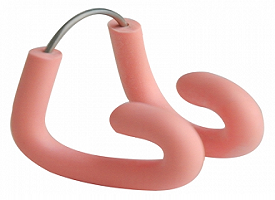
In synchronized swimming, the athletes take to perform a lot of underwater movements. At that place are chances of water entering into the nose of the players. In order to avert that, the athletes utilise a small clip of hard plastic or wire. It also has a thin rubber coating.
Goggles

Goggles provide safety to the eyes. Due to underwater movement, h2o may enter in the eyes. It is important to annotation that the goggles are not immune for routine competitions.
Athletes tin can use goggles only for trainings. This is only used for effigy test. Like goggles, athletes also cannot use the bathing caps during routine competitions. During figure examination, only a white or black bathing cap is worn by athletes.
Underwater Speakers
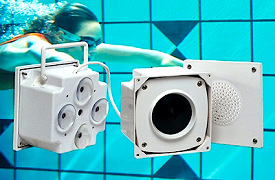
The most important equipment for synchronized swimming is the underwater speakers. Swimmers cannot perform under water if the music is not audible. Music plays an important role in synchronized swimming because information technology is a rhythmic sport.
We know that impedance of h2o is 3600 times more than that of air. There is as well a 62 dB (decibel) start betwixt the sound that travels in air and that in water. To overcome this problem, the underwater speakers used in synchronized swimming depend on Piezoelectric Technology.
Swimsuit
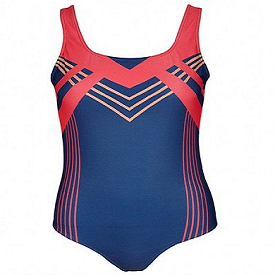
1 of the most important aspects of the swimsuit is that it must exist comfortable for the athletes and it must be non-transparent. During the figure test, a black swimsuit is recommended for the athletes and during routine competition, a routine conform for each athlete that suits the music is recommended.
It may besides happen that athletes perform in two events similar duet and squad effect. In such a state of affairs, the athletes volition exist provided with two dissimilar swimsuits.
How to Play Synchronized Swimming?
In earlier days, synchronised swimming was known as Water Ballet. History says that the first recorded international competition was held in Berlin, Federal republic of germany in 1891. Subsequently that event, many countries shown interest and clubs from respective countries were formed to play and organise competitive matches. Some of the skills performed in this sport are as follows −
Eggbeater
All the synchronised swimmers must have a clear idea near the eggbeater skill. It is one of the virtually key skills in this sport. In this skill, a swimmer can attain stability and reach to a superlative in a higher place the h2o. And then she can leave the hands free to perform other acts. An athlete can reach as much height equally possible merely the average pinnacle is around chest level.
Though, this is a sport, but it is choreographed because of music and dance. By eggbeater, the athlete comes above the water level and is upright. At the same time, she has to put either both of her arms or at least a unmarried arm in the air. It does not terminate with this. If a swimmer wants to go upwards vertically in the air in a higher place the water, there is boost technique. This is performed by an eggbeater build-up followed by a potent team endeavor by legs to propel the swimmer out of the water vertically.
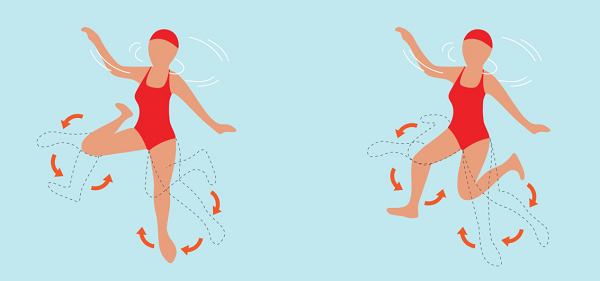
Sculls
Eggbeater skill is normally performed past legs but, on the contrary, sculls mainly depend on hands. The hands of the other supporting athletes are used to propel the body of an athlete. There are different types of sculls used in synchronised pond.
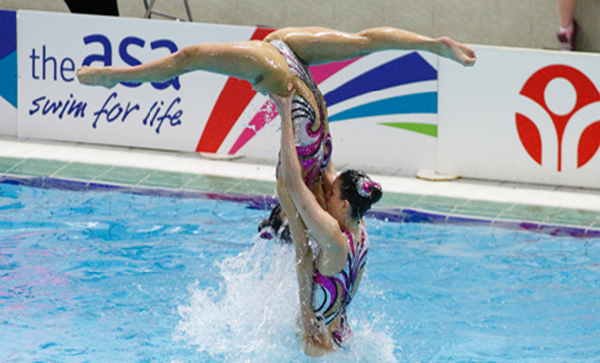
The famous and nearly used scull techniques are support scull, torpedo scull, and propeller scull.
The other techniques which are also widely performed are stationary scull, alligator scull, paddle scull, barrel scull, and split arm scull.
There are also other sculls similar reverse scull and direct propeller which are used in preparation.
Positions
In synchronized swimming, there are a number of positions which will non allow yous to glimmer your eyes. These are very famous and overall look very charming and graceful when athletes perform.

Following are some of the positions −
Tub − In this position, both of the legs are raised up to the chest. The shins and top of the feet should exist parallel to the water.
Dissever Position − Ane of the legs of the swimmer is extended back and one is stretched forward along the surface but the swimmer has to be in vertical position.
Knight − Here the legs are flat on the surface of h2o and to make a knight'southward posture the head is vertically in line with the hips. At the same time, the torso is biconvex on the surface.
Heron or Bent Knee − Here as well the body will be in a vertical position and, as the name suggests, 1 leg volition be bent and the other one will be straight.
Crane − Here the torso of the swimmer should exist in vertical position and being in this position, one leg should be in vertical position and other should exist parallel to the surface.
Side Fishtail − This is similar like a crane position merely a side Y posture is additional in this position.
Dorsum Layout − This a normal bones swimming position where a swimmer lies and swims on surface looking up and sculling under her hips.
Front Layout − In this position, the swimmer's face will be nether the surface and the back is up. The swimmer has to perform sculling by her chest and no breathing shall be done.
Flamingo − In this position, the bottom leg has to be pulled upwards to the chest in such a way that its shin touches the knee of the vertical leg.
Ballet Leg − Here i leg is extended and held perpendicular to the body and the other one is parallel to the surface.
Synchronized Swimming - Rules
FINA or Federation Internationale de Natation or (International Swimming Federation) is the governing body for synchronized swimming. FINA is recognized by international Olympic Committee (IOC) for assistants and command over international competitions on aquatics. Its head function is based in Lausanne, Switzerland.
Currently, there are five aquatics competitions which are held during Summer Olympics. These include pond, diving, h2o polo, open water swimming, and synchronized swimming. FINA looks after all these competitions. On 24 July 2009, Julio Maglione of Uruguay was elected every bit FINA president.

Some of the of import rules of synchronized swimming are every bit follows −
-
Earlier participating in the Olympics, the swimmers must articulate the qualifying competitions
-
If we focus on Olympics, there are only two events played in each Olympics i.east. team and duet
-
There are 2 routines included here one is free routine and one is technical routine
-
Players can perform both in team and duets
-
Technical routine is predetermined and should exist performed strictly according to sure elements
-
Free routine is not predetermined so the players are gratis to practise their functioning and in free routine, they have to prove their creativity in choreography, dancing, and coordination
-
In duet event, there are 2 swimmers and one alternate swimmer. In free routine, the time limit is 3:30 minutes and in technical routine time limit is 2:20 minutes
-
In team event, there are 8 swimmers and one alternate swimmer. Time limit in free routine is 4:00 minutes and 2:50 minutes in technical routine
-
In each outcome, there is relaxation of utmost xv seconds
-
The judges requite points according to the level of difficulty of the functioning shown by the players
-
Marks awarded ranges from 0.0 to 10.0
Synchronized Pond - Champions
FINA or Federation Internationale de Natation or (International Swimming Federation) is the governing body for synchronized swimming. This regulates the international championships all over the world. Autonomously from this, every country has its own governing body to regulate the game. The list of some of the important championships is as follows.
- Globe Aquatic Championships
- FINA World Junior Synchronized Swimming Championships
- USA Synchronized Swimming Championships
- European Synchronized Swimming Championships
- European Aquatics Championships
Synchronized swimming is an audacious sport where the players have to play their tricks while being in water. Some of the champions of this sport are as follows −
Olga Brusnikina
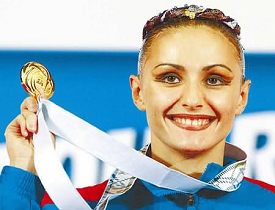
Olga Brusnikina is a synchronized swimmer from Russia, who has won Olympics 3 times. At the starting of her career, she took office in solo routine in 1993 Globe Junior Synchro Championships. In the year 2000, she won a gilded medal in duet and her partner was Mariya Kiselyova.
In 2004 Summer Olympics, she won a gold medal. She got married in 2001 and lived in Italy. She also coached this sport in Moscow Oblast. Currently, she has been elected as member of government commission in physical education and sport of Russian Olympics.
Carolyn Waldo
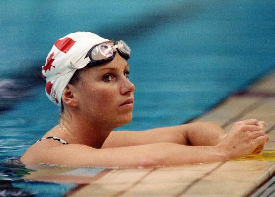
Carolyn Waldo is a synchronized swimmer from Canada who has competed every bit solo and duet in international Competitions. She has the tape of winning 2 golds in 1 Olympics. She has done this in 1988 where she has won both solo and duet competitions. In 1984 Olympics, she was a winner of silver medal. In 1985, she participated in Rome Open and Spanish Open and won both of them.
In the same twelvemonth, she also won FINA World Loving cup. In 1986 also, she won Spanish Open. In 1986, she also took role in Commonwealth Games and Earth Championships and won both of them. In 1987, she won Pan Pacific Championship and FINA World Cup. She announced her retirement in 1988.
Tracie Ruiz
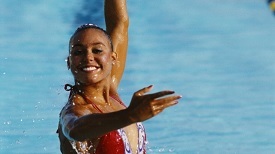
Tracie Ruiz is a synchronized swimmer from U.s. who has won Olympics three times. In her whole career, she has won 41 gold medals in various competitions. In 1983 and 1987 Pan Games, she won one gold in each.
In 1984 Summer Olympics, she won a gold and in 1988 Olympics, she won silver. In 1982 Globe Aquatic Championships, she won a silvery in duet with her partner Processed Costie. At the national level, she has won all the Us Competitions from 1981 to 1986.
Angelika Timanina

Angelika Timanina is a synchronized swimmer from Russia She has won European Championships seven times and World Championships eight times. Along with this, she has as well won a gold medal in 2012 Summer Olympics.
She liked this sport since her childhood so she moved to Moscow to go grooming in the Sport School of preparation of Olympic Reserve – Trud. In 2008 FINA World Cup, she won bronze medal in duet with her partner Daria Korobova.
In 2009, she took part in World Cup and won two gilt medals in free and technical routines. In 2010, she took office in European Aquatic Championship and her team won gold medals.
Anna Kozlova

Anna Kozlova is a synchronized swimmer from Soviet Union. At the starting of her career, she took part in 1989 World Cup but could not win any medal. But in 1991 World Cup, she won a bronze medal for Soviet Union. In the same he she won a gilded medal with her partner Olga Sedakova in duet routine.
In 1993, she took part in European Aquatics Championships with her partner and won gold in duet. After 1993 championship, she went to USA and got her green carte du jour in 1994. After that she took part in many championships but failed to receive whatsoever medal. Just in 2002 World Loving cup, 2003 Pan Games, and 2004 Summer Olympics she won a bronze medal, two gold medals, and a bronze medal respectively.
How Deep Is The Water In Synchronized Swimming,
Source: https://www.tutorialspoint.com/synchronized_swimming/synchronized_swimming_quick_guide.htm
Posted by: rossarishe.blogspot.com


0 Response to "How Deep Is The Water In Synchronized Swimming"
Post a Comment